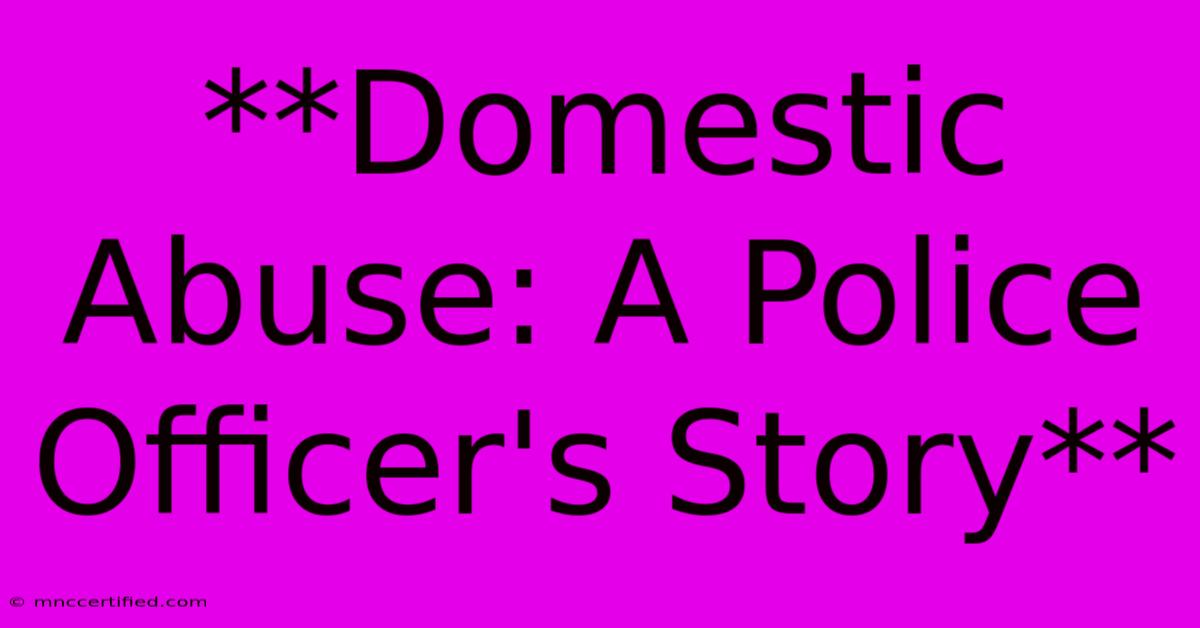**Domestic Abuse: A Police Officer's Story**

Table of Contents
Domestic Abuse: A Police Officer's Story
Domestic abuse is a pervasive issue that affects millions of people worldwide. It's not just a physical assault; it's a complex web of control, manipulation, and intimidation that can leave victims feeling trapped and isolated. Today, we hear from a police officer who has witnessed firsthand the devastating impact of domestic abuse and the vital role law enforcement plays in breaking the cycle of violence.
A Day in the Life
Officer Sarah, a veteran of the force, recalls countless calls related to domestic violence. "It's never the same," she says, "but there's a chilling familiarity to the situations. The fear in the victim's eyes, the justifications the abuser gives, the undeniable tension in the air – it's something that stays with you."
One particular case sticks with Sarah. A young woman, visibly shaken, called the police after her partner had punched a hole in the wall during an argument. The woman was hesitant to press charges, citing fear of retaliation and a hope that her partner would change.
"That's the insidious nature of abuse," Officer Sarah explains. "The abuser often isolates the victim, making them believe they have nowhere else to turn. They use guilt, shame, and even threats to maintain control."
Breaking the Cycle
Officer Sarah and her colleagues understand the immense courage it takes for victims to come forward. They are trained to be compassionate and empathetic, providing support and resources. "We are not just there to arrest the abuser," she emphasizes, "but to protect the victim and offer them a path to safety."
This includes connecting victims with shelters, counseling services, legal aid, and support groups. The goal is to empower them to take control of their lives and break free from the cycle of abuse.
The Role of the Community
Officer Sarah underscores that law enforcement cannot tackle domestic abuse alone. "It requires a collective effort," she stresses. "We need community organizations, social workers, educators, and even neighbors to be vigilant and willing to intervene when they witness signs of abuse."
Recognizing the warning signs, knowing how to offer support, and understanding the resources available are crucial for creating a safer environment for victims.
Moving Forward
The fight against domestic abuse is ongoing. Officer Sarah believes that raising awareness, challenging societal norms, and promoting open conversations are essential steps. "It's about dismantling the stigma surrounding domestic violence and creating a culture where victims feel empowered to seek help," she says.
By supporting victims, holding abusers accountable, and promoting healthy relationships, we can work towards a future where domestic violence is no longer tolerated.
Keywords: Domestic abuse, police, officer, story, victim, abuser, cycle of violence, support, resources, community, awareness, empowerment, safety.
On-Page SEO:
- Title: A strong and relevant title that includes keywords like "Domestic Abuse," "Police," and "Story"
- Meta Description: A concise summary of the article that includes keywords and entices readers to click
- Headers (H2, H3): Used effectively to structure the content and highlight important points
- Keywords: Strategically integrated throughout the article to optimize for search engines
- Internal and External Links: Relevant links to credible sources and other articles on the topic
- Image Optimization: An image used in the article should be optimized with alt text that includes keywords
Off-Page SEO:
- Social Media Promotion: Share the article on relevant social media platforms
- Guest Posting: Consider guest posting on other websites related to domestic abuse
- Backlinks: Build high-quality backlinks from reputable websites
- Community Outreach: Engage with organizations that support domestic abuse victims
By implementing these SEO strategies, you can create a valuable and informative article that ranks well on Google and reaches a wider audience.

Thank you for visiting our website wich cover about **Domestic Abuse: A Police Officer's Story**. We hope the information provided has been useful to you. Feel free to contact us if you have any questions or need further assistance. See you next time and dont miss to bookmark.
Featured Posts
-
Barcelona Handball Team Wins Catalan Award
Nov 12, 2024
-
James Bond Beach Oracabessa Jamaica
Nov 12, 2024
-
Fc Barcelona Handball Takes Catalan Federation Honor
Nov 12, 2024
-
Homan Fires Back At Border Critics
Nov 12, 2024
-
Online Car Insurance Quotes Blogspot
Nov 12, 2024